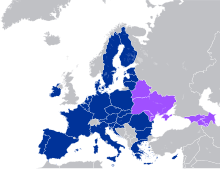A European Union Association Agreement or simply Association Agreement (AA) is a treaty between the European Union (EU), its Member States and a non-EU country that creates a framework for co-operation between them. Areas frequently covered by such agreements include the development of political, trade, social, cultural and security links.
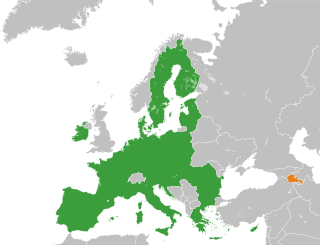
Armenia and the European Union have maintained positive relations over the years. Both parties are connected through the Comprehensive and Enhanced Partnership Agreement (CEPA), which was signed in 2017. Armenian former Foreign Minister Eduard Nalbandyan expressed confidence that the new partnership agreement would "open a new page" in EU-Armenia relations. While, the former High Representative of the Union for Foreign Affairs and Security Policy, Federica Mogherini concluded in June 2019, that Armenia-EU relations are on an “excellent” level.

Relations between Canada and the European Union (EU) and its forerunners date back to the 1950s. While the relationship is primarily an economic one, there are also matters of political cooperation. Canadians also use English and French — both European languages — as official and majority languages.
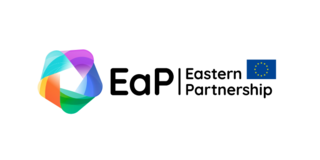
The Eastern Partnership (EaP) is a joint initiative of the European External Action Service of the European Union (EU) together with the EU, its member states, and six Eastern European partners governing the EU's relationship with the post-Soviet states of Armenia, Azerbaijan, Belarus, Georgia, Moldova, and Ukraine. The EaP is intended to provide a forum for discussions regarding trade, economic strategy, travel agreements, and other issues between the EU and its Eastern European neighbours. It also aims at building a common area of shared values of democracy, prosperity, stability, and increased cooperation. The project was initiated by Poland and a subsequent proposal was prepared in co-operation with Sweden. It was presented by the foreign ministers of Poland and Sweden at the EU's General Affairs and External Relations Council in Brussels on 26 May 2008. The Eastern Partnership was inaugurated by the European Union in Prague, Czech Republic on 7 May 2009.
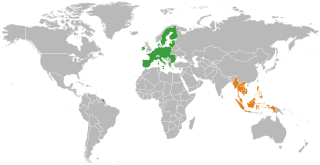
The ASEAN–European Union relations refers to bilateral foreign relations between the two organisations; the European Union (EU), and the Association of South-East Asian Nations (ASEAN). EU and ASEAN have been interacting with each other on the economic, trade, and political levels for more than four decades. The partnership between the EU and ASEAN dates back to 1972, when the EU became ASEAN's first formal dialogue partner.

The Euronest Parliamentary Assembly is the inter-parliamentary forum in which members of the European Parliament and the national parliaments of Ukraine, Moldova, Armenia, Azerbaijan and Georgia participate and forge closer political and economic ties with the European Union. It was established in 2011 by the European Commission as a component of the Eastern Partnership. After the elections in Belarus in 2010 were declared as flawed by the OSCE, the membership of Belarus in Euronest was automatically suspended. Belarus is welcome to re-join the Assembly once political requirements have been fulfilled. In 2015, Azerbaijan's membership was suspended due to the European Union's criticism of human rights abuses by the government. In September 2016, it was announced that Azerbaijan would take the necessary steps towards restoring ties. As of 2017, the combined population of Euronest members stands at 61,927,521 people.

Relations between the European Union and the Republic of India are currently defined by the 1994 EU–India Cooperation Agreement. The EU is a significant trade partner for India and the two sides have been attempting to negotiate a free trade deal since 2007. Indo-EU bilateral trade stood at US$104.3 billion in the financial year 2018–19.

European Union–Kazakhstan relations are the international relations between the Republic of Kazakhstan and the common foreign policy and trade relations of the European Union.

The Eurasian Economic Union is an economic union of some post-Soviet states located in Eurasia. The Treaty on the Eurasian Economic Union was signed on 29 May 2014 by the leaders of Belarus, Kazakhstan, and Russia, and came into force on 1 January 2015. Treaties aiming for Armenia's and Kyrgyzstan's accession to the Eurasian Economic Union were signed on 9 October and 23 December 2014, respectively. Armenia's accession treaty came into force on 2 January 2015. Kyrgyzstan's accession treaty came into effect on 6 August 2015. Kyrgyzstan participated in the EAEU from the day of its establishment as an acceding state.
The Paris summit of September 2008 was a major event in the EU-Ukraine bilateral relations. It was hosted by Nicolas Sarkozy, President of France and president-in-office of the European Council. Also, Javier Solana, the High Representative of the EU for common foreign and security policy and some other high-ranking officials from Brussels attended the event.

Mexico and the European Economic Community (EEC) signed an agreement intending to foster economic and trade relations on 15 July 1975. Mexico and the European Union (EU) have had a free trade agreement since 2000 and the two benefit from high investment flows.

The Deep and Comprehensive Free Trade Areas (DCFTA) are three free trade areas established between the European Union, and Georgia, Moldova, and Ukraine respectively. The DCFTAs are part of each country's EU Association Agreement. They allow Georgia, Moldova, and Ukraine access to the European Single Market in selected sectors and grant EU investors in those sectors the same regulatory environment in the associated country as in the EU. The agreements with Moldova and Georgia have been ratified and officially entered into force in July 2016, although parts of them were already provisionally applied. The agreement with Ukraine was provisionally applied since 1 January 2016 and formally entered into force on 1 September 2017.
The future enlargement of the Eurasian Economic Union is theoretically open to any of the Post-Soviet states and potentially any country of Europe or Asia. In order to accede, a state must fulfill certain economic and political requirements. Enlargement of the Union is also subject to the consent of all existing members and the candidate's adoption of existing EEU laws and implementing previous decisions made by the Eurasian Economic Commission. The present agenda of the enlargement of the Eurasian Economic Union is primarily focused on Tajikistan. Meanwhile, Moldova was granted Observer Status in April 2017, followed by Uzbekistan and Cuba in December 2020. The process of enlargement is referred to as Eurasian integration or Eurasianism. This term is also used to refer to the intensification of economic cooperation between Eurasian Economic Union member states.

Mikheil Janelidze is a chairman of Center for European Governance & Economy. He is a former Georgian government official who served as Vice Prime Minister (2017–2018), Minister of Foreign Affairs (2015–2018), First Deputy Minister of Foreign Affairs (2015) and Deputy Minister of Economy and Sustainable Development of Georgia (2011-2015).
A comprehensive economic partnership agreement (CEPA) is a free trade agreement between two countries
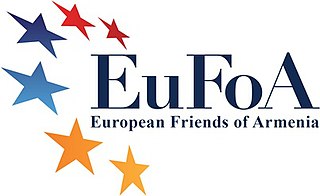
The European Friends of Armenia (EuFoA) is an international non-governmental organization established in 2009, which aims to promote cooperation between the European Union and Armenia.

The Association Trio, also known as the Associated Trio, is a tripartite format for the enhanced cooperation, coordination, and dialogue between the Ministries of Foreign Affairs of Georgia, Moldova and Ukraine with the European Union on issues of common interest related to European integration, enhancing cooperation within the framework of the Eastern Partnership, and committing to the prospect of joining the European Union.

The EU-Armenia Partnership and Cooperation Agreement (PCA) was a Partnership and Cooperation Agreement between the European Coal and Steel Community and Armenia. It was signed in Luxembourg and entered into force on 1 July 1999. The agreement served as the legal framework for EU-Armenia bilateral relations for 21 years, until its termination on 28 February 2021. The PCA was replaced by the Armenia-EU Comprehensive and Enhanced Partnership Agreement (CEPA), a more comprehensive and complex agreement, which entered into force on 1 March 2021.


